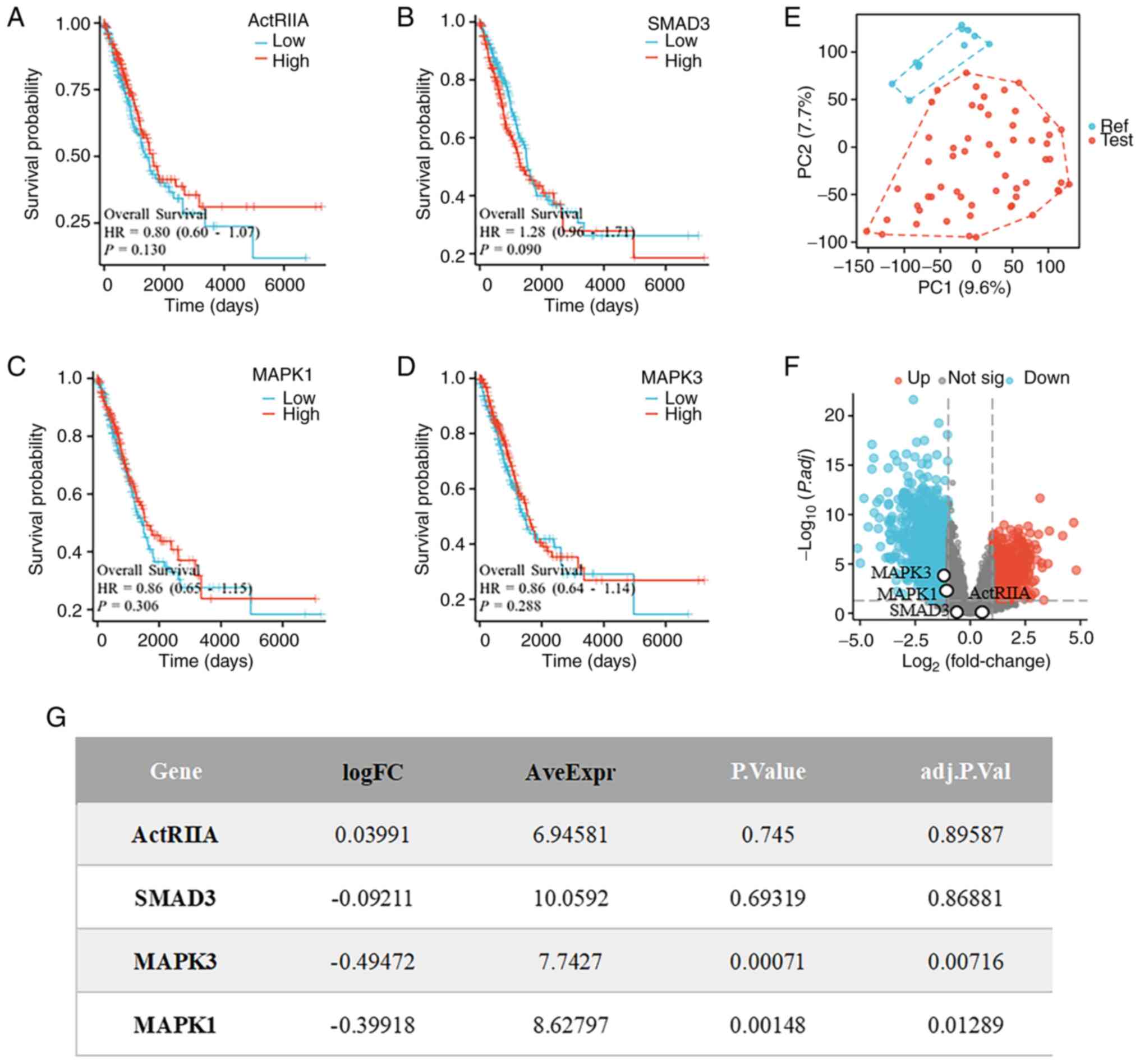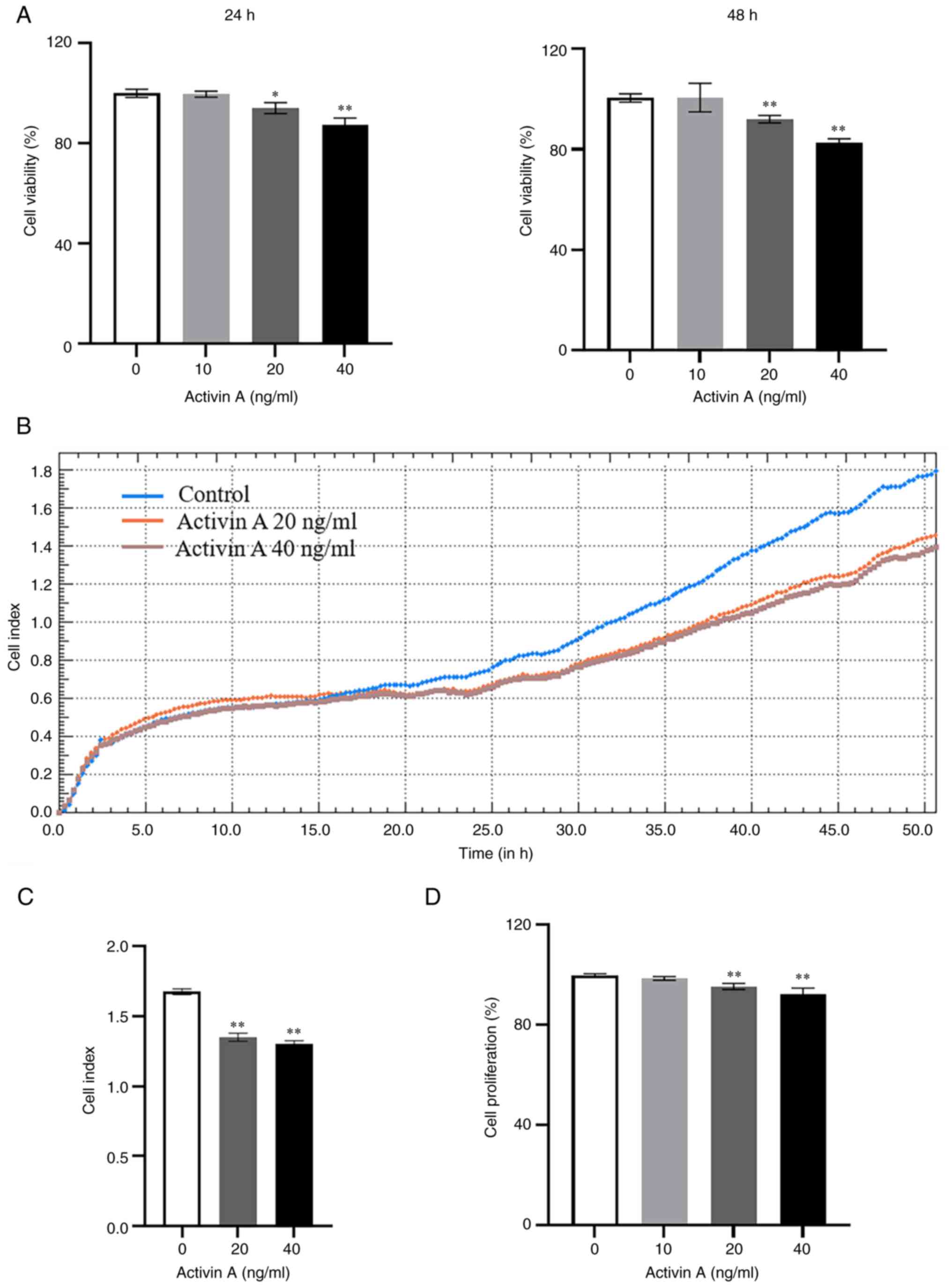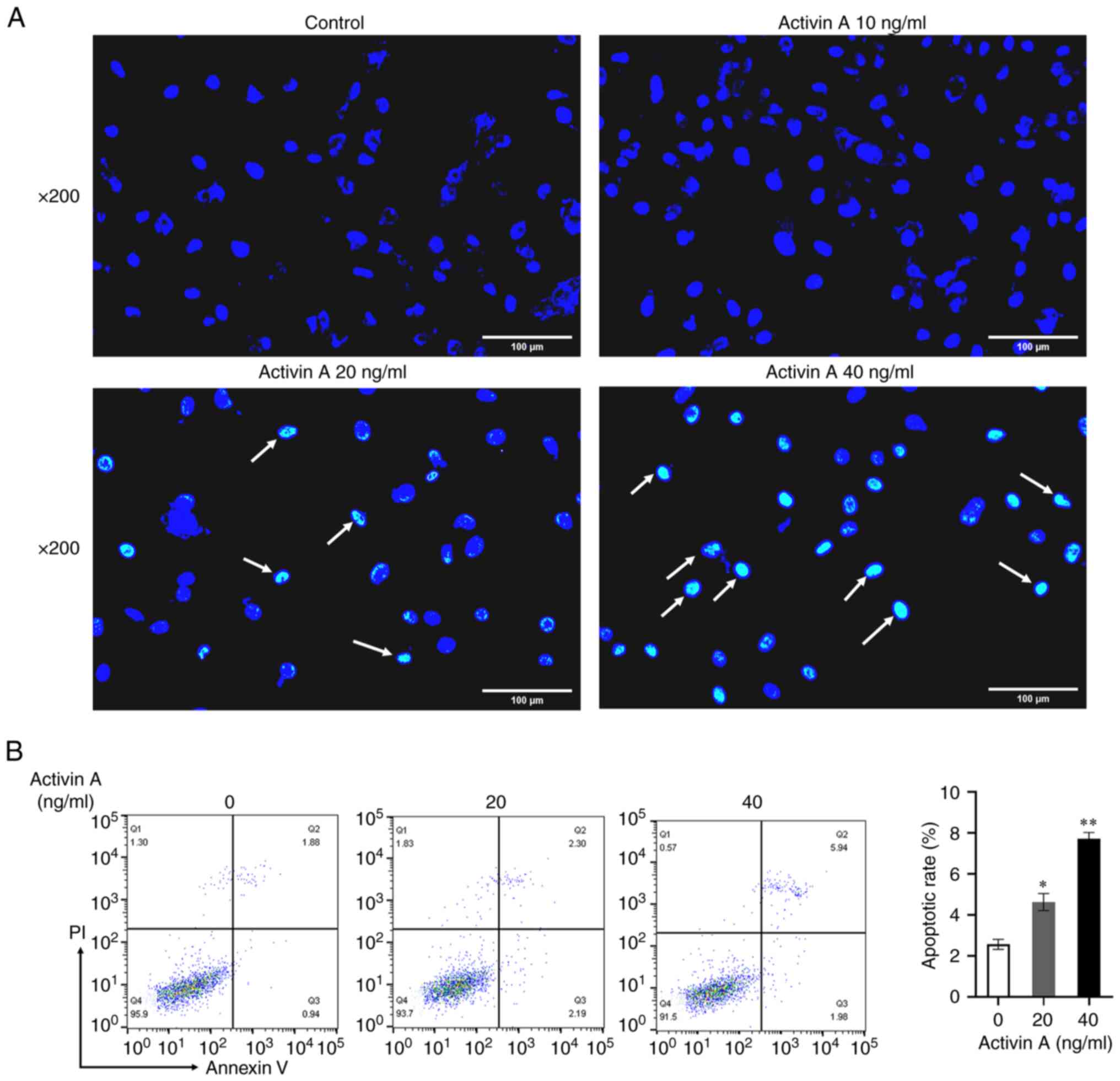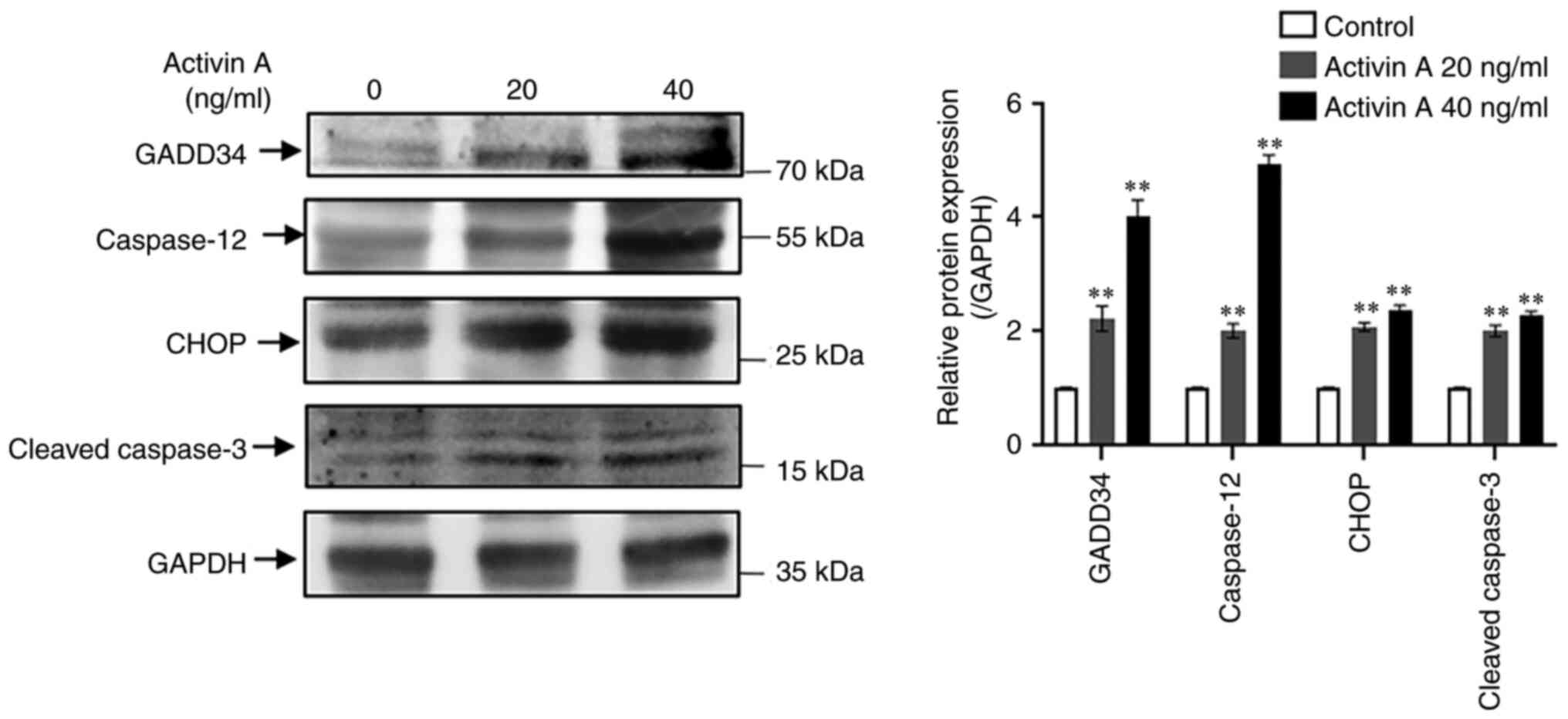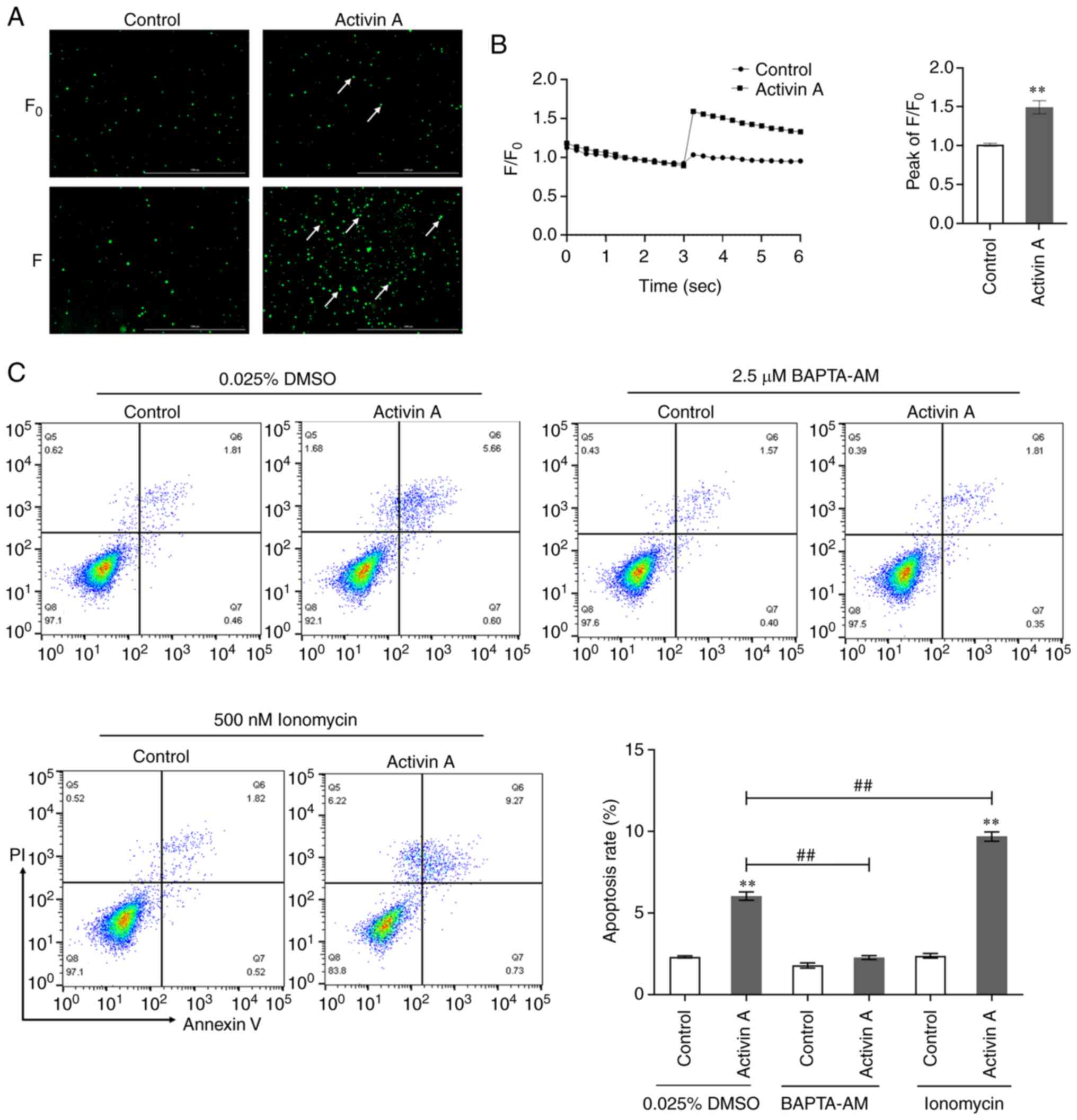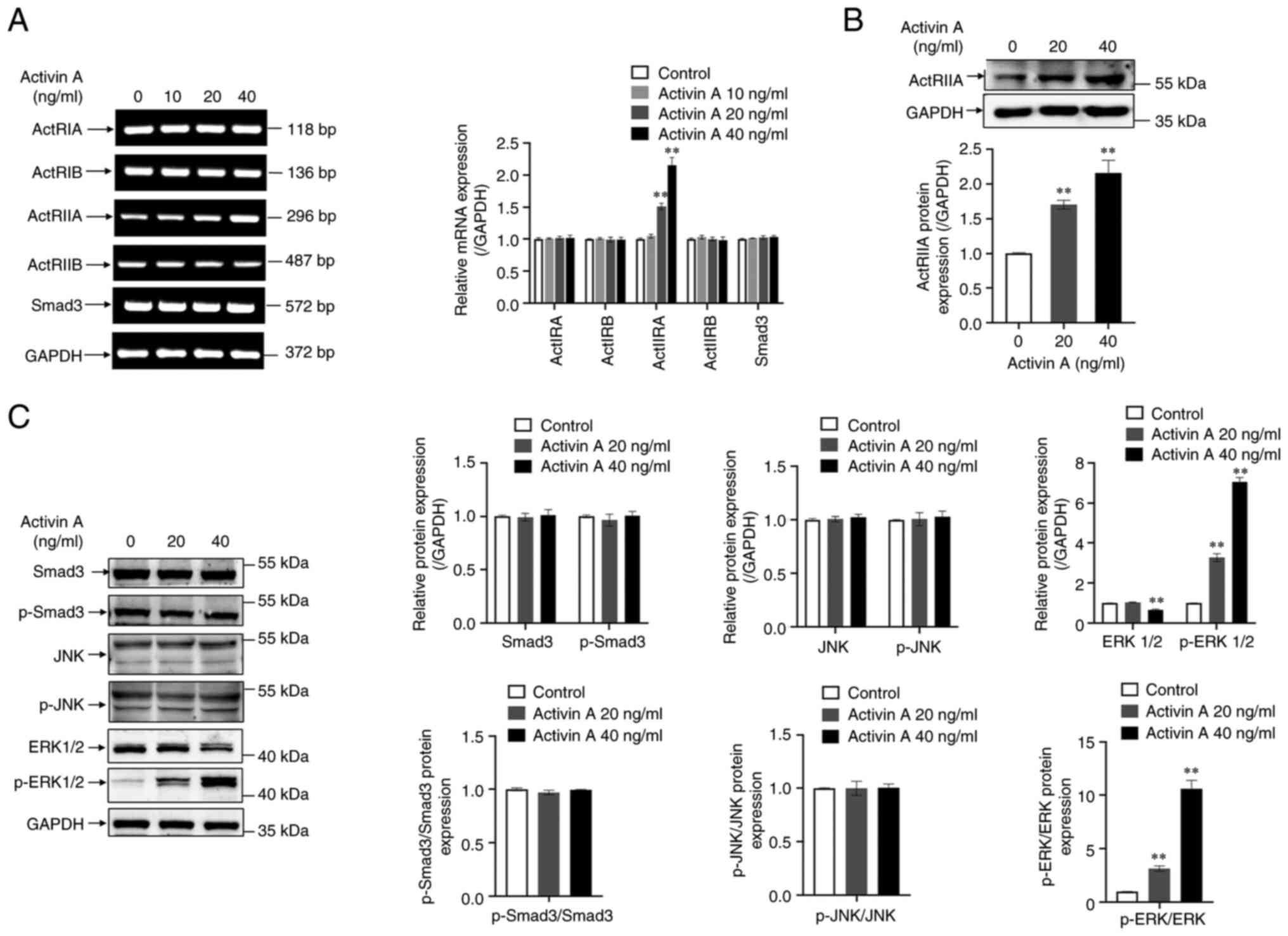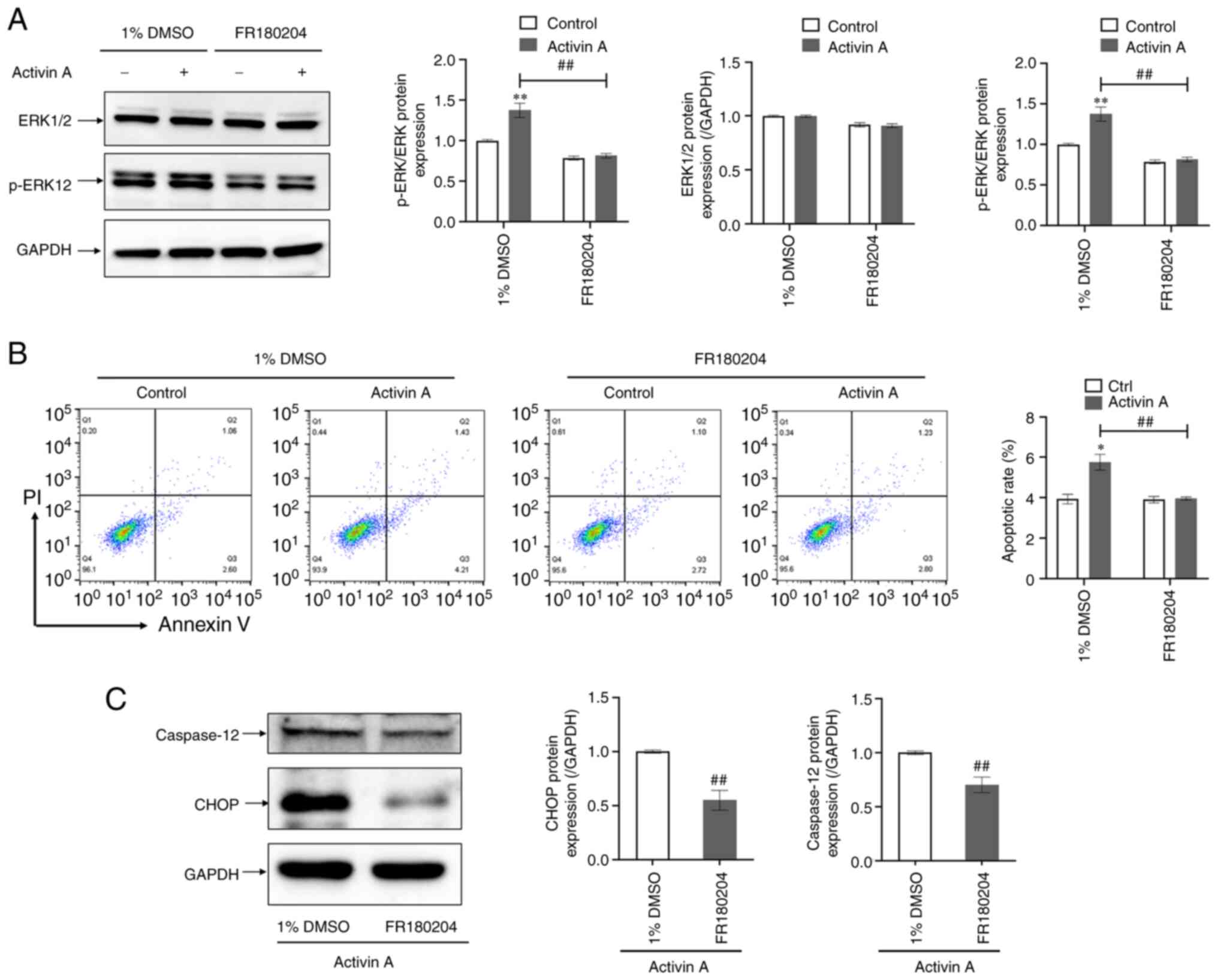Activin A induces apoptosis of human lung adenocarcinoma A549 cells through endoplasmic reticulum stress pathway
- Authors:
- Published online on: December 20, 2023 https://doi.org/10.3892/or.2023.8688
- Article Number: 29
-
Copyright: © Zhang et al. This is an open access article distributed under the terms of Creative Commons Attribution License.
Abstract
Introduction
Lung cancer, a malignant disease of the respiratory system, is the leading cause of cancer-related mortality (1). According to medical convention, lung cancer is classified into two main categories: small cell lung cancer (SCLC) and non-small cell lung cancer (NSCLC) (2). Among the subtypes of NSCLC, lung squamous cell carcinoma and lung adenocarcinoma (LUAD) are the most prevalent, with the latter the most frequently occurring histological type in non-smokers (2). LUAD is often diagnosed at an advanced or metastatic stage, resulting in the loss of early treatment opportunities (3). However, advancements in surgical treatment, including enhanced staging and video-assisted thoracic surgery, have led to improved survival rates across all stages of NSCLC (4). Although much research has been conducted into LUAD therapy, the 5-year survival rate and prognosis of patients with LUAD remain suboptimal (4). Therefore, identification of novel therapeutic interventions is an urgent need.
Activin A, originally extracted from porcine follicular fluid, belongs to the superfamily of transforming growth factors (TGF-β) and induces pituitary cells to secrete follicle stimulating hormone (5). Similar to other TGF-β superfamily members, activin A initiates its signaling cascade by binding to activin receptor type II (ActRII), and then recruits activin receptor type I (ActRI) to form a heterodimer that results in the activation of Smad2 and Smad3 proteins. These proteins then, form a complex with Smad4 (Smad2/3/4), which translocates to the nucleus and drives downstream target genes, leading to biological effects such as cell proliferation, apoptosis and migration (6). Studies have revealed that activin A-overexpression in diverse tissues is involved in tumor progression in various cancers, including LUAD, pancreatic ductal adenocarcinoma, breast cancer and oral squamous cell carcinoma (7–10).
Numerous genetic and environmental insults impede the ability of cells to properly fold and post-translationally modify secretory and transmembrane proteins in the endoplasmic reticulum (ER), leading to a buildup of misfolded proteins in this organelle (11), a phenomenon referred to as ER stress. If ER stress persists chronically at high levels, the unfolded protein response (UPR) transforms into an alternate signaling platform referred to as the terminal UPR that actively promotes cell death (11,12). ER stress and sustained UPR signaling have been well documented in numerous diseases, including diabetes, neurological diseases, pulmonary fibrosis, cancer (multiple myeloma, breast) and heart disease (11). However, triggering excessive ER stress can induce tumor cell death, which may become a therapeutic strategy against tumor growth (13). Although research has demonstrated that activin A plays a neuroprotective role in ER stress-mediated apoptotic and autophagic rat pheochromocytoma PC12 cell death (14), few studies have examined the role of activin A and ER stress in other tumor cells.
Prior research has documented that a high concentration of activin A inhibits the growth of LUAD cells (7) and can result in apoptosis of myeloma NS-1 cells through the ER stress pathway (6). Nevertheless, it remains unclear whether activin A can mediate apoptosis of human LUAD cells via the ER stress pathway. Through gene data comparison, it was found that the expression of ActRIIA and non-classical pathway signaling proteins improved the survival of patients with LUAD. Consequently, the human LUAD cell line A549 was used as the experimental model to explore the potential functions of activin A and identify its underlying mechanisms of inducing apoptosis in LUAD cells.
Materials and methods
Cell culture
The human LUAD cell line A549 (https://www.cellosaurus.org/CVCL_0023; cat. no. CCL-185; American Type Culture Collection) was cultured in RPMI-1640 (cat. no. 11875093; Thermo Fisher Scientific, Inc.) supplemented with 10% fetal bovine serum (FBS) (cat. no. C04001; Shanghai VivaCell Biosciences, Ltd.) and 1% penicillin-streptomycin at 37°C in a humidified incubator with 5% CO2. The cells were passaged every two days.
Cell Counting Kit-8 (CCK-8) assay
A549 cells (1.5×104 cells/well) were seeded into a 96-well plate and incubated in 2% FBS-RPMI-1640 containing activin A (0–40 ng/ml) (cat. no. 338-AC; R&D Systems, Inc.) for 24 and 48 h, respectively. Next, 10 µl of CCK-8 reagent (cat. no. GK10001; GLPBIO) was added to the culture medium of each well, and the cells were incubated for 2 h at 37°C in 5% CO2. The absorbance values (A value) were obtained at the wavelengths of 450 and 650 nm. Each experiment was performed in triplicate compound wells and repeated three times. The percentage (%) of cell viability was calculated as follows: (%)=(sample well A value/control well A value) ×100%.
Real-time cell analysis (RTCA)
RTCA is a powerful technology for detecting cell fate (15). The RTCA instrument (xCELLigence RTCA S16; ACEA Bioscience, Inc.; Agilent) was used to analyze the proliferation property of A549 cells. The experimental method was as previously described (15). In brief, 50 µl of cell-free culture medium (2% FBS-RPMI-1640) was added to the well of an E16 ×CELLigence microtiter plate to test the background impedance of each well for 1 min. Subsequently, A549 cells (1×104 cells in 50 µl culture medium) were added to the plate and cultured at 37°C in 5% CO2 for ~2 h, and then treated with different concentrations of activin A (0–40 ng/ml) for 48 h. Cells were monitored at 15 min intervals. Each experiment was set up with double compound holes and repeated thrice. The cell index indirectly represented cell activity.
5-bromo-2′-deoxyuridine (BrdU), Elisa method for cell proliferation
A549 cells (1.5×104 cells/well) were seeded into a 96-well plate and incubated in 2% FBS-RPMI-1640 containing activin A (0–40 ng/ml) for 24 h. In accordance with a cell proliferation ELISA protocol (cat. no. 11647229001; Merck KGaA), 10 µl of BrdU labeling reagent was added, and incubation was continued for 2 h. After discarding the supernatants, 200 µl/well of FixDenat reagent was added for 30 min to fix the cells and denature the DNA. After discarding the supernatants, 100 µl/well of anti-BrdU-POD was added and followed by incubation for 90 min. After discarding the supernatants and washing, 100 µl/well of substrate solution was added and incubated for 30 min. The absorbance values (A value) were obtained at the wavelengths of 370 and 492 nm. Each experiment was performed in triplicate compound wells. The percentage (%) of cell proliferation was calculated as follows: (%)=(sample well A value/control well A value) ×100%.
Hoechst 33342 staining
A549 cells (1.5×104 cells/well) were seeded into a 96-well plate and cultured in 2% FBS-RPMI-1640 culture medium containing activin A (0–40 ng/ml). Cells were then fixed with 4% paraformaldehyde for 20 min and stained with 10 µg/ml Hoechst 33342 solution (cat. no. 14533; Sigma-Aldrich; Merck KGaA) in the dark for 10 min at room temperature and observed under an inverted fluorescence microscope (IX71; Olympus Corporation). Experiments were repeated three times.
Flow cytometric analysis of cell apoptosis
The experiment was performed as previously described (6). A549 cells (1×105 cells/well) were seeded in a 12-well plate and cultured in 2% FBS-RPMI-1640 culture medium containing activin A (0–40 ng/ml) for 24 h. Thereafter, the cells were collected and suspended in 100 µl of 1X Annexin V binding buffer. Next, 1 µl of Annexin V-YF®488 and 1 µl of PI (cat. no. Y6002; Suzhou Yuheng Biotechnology Co., Ltd.; www.uebio.com) were used to mark the cells for 15 min in the dark. Finally, the labeled cells were analyzed using flow cytometry (guava easyCyte HT; Cytek Biosciences). FlowJo (FlowJo_v10.6.2; FlowJo LLC) was used to collect and analyze the data to obtain the percentage of fluorescent cells. The experiments were repeated three times. BAPTA-AM (2.5 µM; cat. no. HY-100545), calcium agonist ionomycin (500 nm; cat. no. HY-13434; both from MedChemExpress) and ERK inhibitor FR180204 (10 µM; cat. no. abs810541; Absin Bioscience, Inc.) were also used before assessment of cell apoptosis.
Calcium influx assay
A549 cells were incubated in 2% FBS-RPMI-1640 medium with 4 µmol/l Fluo-4 (cat. no. F14201; Thermo Fisher Scientific, Inc.) and were protected from light for 40 min at 37°C. The cells were then washed twice with 2% FBS-RPMI-1640 medium and seeded into a 24-well plate. Calcium fluorescence signaling was detected using a BioTek Cytation5 cell imager multimode reader (Agilent Technologies, Inc.) after the cells were adherent. The baseline fluorescence signal (F0) was recorded every 0.25 sec for a total of 3 sec. Next, the cells were treated with 2% FBS-RPMI-1640 and activin A 20 ng/ml, respectively, and the fluorescence signal (F) was immediately detected on the machine for another 3 sec. The experimental data were exported from BioTek Cytation5 software, and the normalized fluorescence intensity was represented by F/F0. Experiments were repeated three times.
Reverse transcription-polymerase chain reaction (RT-PCR)
The experiment was performed as previously described (16). Total RNA from A549 cells was extracted using RNAiso Plus reagent (cat. no. 9108; Takara Biomedical Technology Co., Ltd.) and the cDNA synthesis kit (cat. no. CW2020M; CoWin Biosciences) was used to complete the reverse transcription according to the manufacturer's instructions. PCR was performed using 2X Es Taq MasterMix (cat. no. CW0690H; CoWin Biosciences). The qPCR thermocycling conditions were as follows: 95°C for 1.5 min, 94°C for 0.5 min, 56°C for 0.5 min and 72°C for 1 min for 30 cycles, with a final 10-min extension step at 72°C. Finally, 2% agarose gel electrophoresis stained with Super Gelred (cat. no. S2001; Suzhou Yuheng Biotechnology Co., Ltd.; www.uebio.com.) was used to separate PCR products. The PCR bands were visualized using ImageMaster VDS. ImageJ software (version 1.53e; National Institutes of Health) was used to digitalize the bands. Primer sequences are included in Table I.
Western blotting
The experiment was performed as previously described (16). Briefly, A549 cells were lysed using protein extraction reagent (cat. no. 78503; Thermo Fisher Scientific, Inc.) containing protease & phosphatase inhibitor cocktail (cat. no. 87785; Thermo Fisher Scientific, Inc.) and 5 mmol/l EDTA solution (cat. no. R1021; Thermo Scientific, Inc.). According to the instructions, the BCA protein assay kit (cat. no. 23227; Thermo Fisher Scientific, Inc.) was applied to quantify the proteins, which were obtained from centrifugation of 12,000 g at 4°C for 20 min. Then, 10% SDS-PAGE gel electrophoresis was performed to separate 30 µg of protein. After electrophoresis, the product was transferred onto polyvinylidene difluoride membrane (cat. no. IPVH00010; Sigma-Aldrich; Merck KGaA). Next, the membranes were blocked with 5% skim milk in TBS-Tween 20 for 2 h at room temperature (RT), and then incubated with specific primary antibodies overnight at 4°C. The corresponding horseradish peroxidase-conjugated secondary antibodies (1:160,000; Goat anti-mouse IgG for CHOP antibody, cat. no. A3682; Goat anti-rabbit IgG for other antibodies, cat. no. A0545; all from Merck KGaA) were further incubated for 2 h at RT. Finally, the bands attached to the membrane were visualized using an ECL luminescence reagent (cat. no. BL520; Biosharp Life Sciences) using a Tanon 4600 chemiluminescent imaging system. The immunoblots were quantified using ImageJ software, and the levels of proteins were normalized against GAPDH. The following antibodies were used for western blotting: ActRIIA (1:1,000; cat. no. abs149480), GAPDH (1:10,000; cat. no. abs132004; both from Absin Bioscience, Inc.), GADD34 (1:1,000; cat. no. ab131402; Abcam), CHOP (1:1,000; cat. no. 2895), cleaved-caspase3 (1:1,000; cat. no. 9661), ERK1/2 (1:1,000; cat. no. 4695), phosphorylated (p)-ERK1/2 (1:2,000; cat. no. 4370), p-Smad3 (1:1,000; cat. no. 9520), Smad3 (1:1,000; cat. no. 9523; all from Cell Signaling Technology, Inc.), caspase-12 (1:1,000; cat. no. WL03268), JNK (1:1,000; cat. no. WL01295) and p-JNK (1:1,000; cat. no. WL01813; all from Wanleibio Co., Ltd.).
Kaplan-Meier (K-M) survival curves analysis
The data of The Cancer Genome Atlas (TCGA)-LUAD were obtained from Genomic Data Commons Data Portal (https://portal.gdc.cancer.gov/projects/TCGA-LUAD). GBM R package (https://www.rdocumentation.org/packages/gbm/versions/2.1.8.1) was used to analyze the data. Cox proportional hazard regression model was used to analyze and determine independent risk factors, and estimate the hazard ratio (HR) and 95% confidence interval.
Microarray-based data analysis
RNA-sequencing expression profiles and corresponding clinical information for TCGA-LUAD were downloaded from the TCGA dataset. GSE116959 profiles were obtained from the Gene Expression Omnibus (GEO) database (https://www.ncbi.nlm.nih.gov/geo/query/acc.cgi?acc=GSE116959). The GSE116959 dataset was generated using GPL17077 Agilent-039494 SurePrint G3 Human GE v2 8×60K Microarray 039381 platform and included 57 LUAD samples and 11 peritumoral normal lung tissues. The raw data were downloaded as MINiML files and preprocessed via background adjustment, normalization. Limma package (versions 3.18; Bioconductor–limma) was used to analyze the data.
Statistical analysis
All data are presented as the mean ± standard deviation. Statistical analysis was conducted using SPSS software (version 26; IBM Corp.). Comparisons were performed using unpaired Student's t-test or one-way analysis of variance (ANOVA), followed by the least significant difference (LSD) test. P<0.05 was considered to indicate a statistically significant difference.
Results
ActRIIA-MAPK signaling affects the survival of LUAD
To confirm the clinical value of activin signaling activation in LUAD, LUAD data were first obtained from TCGA database and the K-M survival curves of ActRIIA and its downstream signaling proteins in LUAD were analyzed. Although the association did not reach the level of statistical significance, it was found that high expression of ActRIIA was positively associated with the survival of patients with LUAD, which was consistent with the positive effects of mitogen-activated protein kinase 1 (MAPK1; ERK2) and MAPK3 (ERK1) on their survival. By contrast, high expression of Smad3 (HR=1.28 >1) was negatively associated with their survival (Fig. 1A-D). Moreover, when the gene expression profiles of 11 non-tumor samples and 57 LUAD tissue samples from the GEO Series GSE116959 database for the identification of differentially expressed genes were examined, we found significant differences between the LUAD and non-tumor samples (Fig. 1E). In addition, the results of microarray-based data analysis revealed that MAPK1 and MAPK3 were negatively associated with LUAD (Fig. 1F and G), suggesting that MAPK1 and MAPK3 might be signaling molecules positively associated with the survival of patients with lung cancer. These results indicated that ActRIIA-ERK1/2 signaling may have inhibitory effects on LUAD cells.
Activin A inhibits A549 cell viability and proliferation
The results of CCK-8 assay indicated that the viability of A549 cells decreased significantly after stimulation with 20 and 40 ng/ml of activin A for 24 and 48 h, respectively (Fig. 2A). RTCA was then performed, a non-invasive and effective tool for real-time dynamic monitoring of cell growth that is widely used for measuring cell proliferation and adhesion (15,17), to assess the proliferation of A549 cells. The results also demonstrated that activin A significantly inhibited the proliferation of A549 cells (Fig. 2B and C), which was consistent with the observed decrease in cell viability. The proliferation of A549 cells was further evaluated by BrdU incorporation. The results revealed that the proliferation of A549 cells decreased significantly after treatment with activin A, compared with that in the control group (Fig. 2D). These results indicated that activin A can suppress A549 cell proliferation.
Activin A induces apoptosis of A549 cells
To ascertain whether activin A inhibits A549 cell proliferation through apoptosis, Hoechst 33342 staining was performed to observe alterations in cellular morphology. The results showed that the number of apoptotic cells in the activin A-stimulated group increased obviously compared with the control group (Fig. 3A). Flow cytometry was then used to detect apoptotic ratio of A549 cells. The results revealed that, compared with the control medium, the apoptotic rate of A549 cells stimulated with 20 ng/ml and 40 ng/ml of activin A increased significantly (Fig. 3B), suggesting that activin A can induce A549 cell apoptosis.
Activin A promotes the expression of proteins related to the ER stress pathway in A549 cells
To explore whether activin A mediates apoptosis of A549 cells via the ER stress pathway, western blotting was performed to detect the expression of proteins associated with the ER stress pathway in A549 cells. The results revealed that the levels of GADD34, CHOP, caspase-12 and cleaved-caspase-3 proteins in A549 cells were significantly upregulated by activin A (Fig. 4), indicating that activin A may induce apoptosis of A549 cells through the ER stress pathway.
Activin A enhances calcium influx in A549 cells
Calcium signaling is associated with various biological behaviors such as cell proliferation, differentiation and migration (18,19), and exerts a crucial impact on both ER stress-induced apoptosis and mitochondria-mediated apoptosis (20). When the calcium fluorescence probe Fluo-4 AM was used to measure intracellular calcium levels in A549 cells, it was identified that the fluorescence signal intensity of calcium in A549 cells was significantly increased by activin A treatment (Fig. 5A and B). To clarify whether calcium signaling has a role in the activin A-induced cell apoptosis process, A549 cells were treated with intracellular calcium ion chelator BAPTA-AM and calcium agonist ionomycin, before assessing cell apoptosis by flow cytometry. The present results revealed that BAPTA-AM reversed activin A-mediated apoptosis of A549 cells, whereas ionomycin increased the rate of apoptosis induced by activin A (Fig. 5C). These findings indicated that activin A induces apoptosis of A549 cells by promoting cellular calcium influx.
Activin A increases p-ERK1/2 and ActRIIA protein levels in A549 cells
Activin A can regulate cell activity through the canonical Smad3 dependent or non-Smad3 signaling pathways. Initially, RT-qPCR was performed to determine the levels of activin receptor and Smad3 mRNA expression in A549 cells. Whereas ActRIA, ActRIB, ActRIIB and Smad3 mRNA levels in A549 cells did not significantly change with activin A treatment, ActRIIA mRNA level significantly increased (Fig. 6A). Similarly, activin A significantly upregulated ActRIIA protein levels in A549 cells (Fig. 6B). The results of western blotting indicated that activin A did neither significantly affect the p-Smad3 and p-JNK protein levels, nor the p-JNK/JNK or p-Smad3/Smad3 ratio in A549 cells. However, the p-ERK1/2 protein level and p-ERK/ERK ratio were significantly elevated by activin A (Fig. 6C). The aforementioned findings indicated that activin A may regulate ER stress pathway-triggered A549 cell apoptosis via the Smad-independent ERK1/2 signaling.
ERK inhibitor FR180204 attenuates activin A-induced apoptosis of A549 cells
To confirm that ERK1/2 is involved in the ER stress pathway-mediated apoptosis of A549 cells triggered by activin A, the ERK inhibitor FR180204 was used to pretreat A549 cells for further experiments. It was found that administration of FR180204 resulted in a significant reduction in the p-ERK protein level and the p-ERK/ERK ratio in activin A-treated cells (Fig. 7A) as well as in the apoptotic rate of activin A-induced A549 cells (Fig. 7B). In the next experiment, it was identified that FR180204 significantly downregulated caspase-12 and CHOP protein levels in activin A-treated A549 cells (Fig. 7C). These findings indicated that the ERK signaling pathway participates in activin A-induced A549 cell apoptosis through the ER stress pathway.
Discussion
Unlike inhibin, which contains an α-subunit, activin, a homologous or heterodimeric dimer glycoprotein, is composed of two β-subunits linked by disulfide bonds (21). To date, four different molecular forms of activins have been identified, specifically activin A (βA/βA), activin B (βB/βB), activin AB (βA/βB) and activin E (βE/βE). Only activin A, B and AB have been determined to have defined biological activities (22). However, a previous study found that activin E also has important biological effects as a liver cytokine (23). The activin family member activin A has garnered significant attention in academic research owing to its ubiquitous tissue distribution and multifaceted biological impact. Specifically, activin A has been found to play crucial roles in embryogenesis, inflammatory responses, cellular proliferation and differentiation, arterial pressure modulation and neoplastic progression (24–27). Recent studies have reported that, similar to TGF-β, activin A plays a dual role in inhibiting and promoting cancer. For example, activin A can inhibit the proliferation of mouse liver cancer cells and human gastric cancer cells in vitro (28,29), but can enhance the proliferation of human ovarian cancer cells and human osteosarcoma cells (30,31).
It is evident that activin A elicits diverse biological responses in distinct tumor cells, having both positive and negative effects on cell proliferation. Therefore, the role of activin A cannot be generalized. Overexpression of inhibin βA (INHβA) has been confirmed in the tumor tissues of patients with LUAD (7). Moreover, subsequent studies have shown that lung cancer highly expresses the activin binding protein-follistatin (FST), which is positively correlated with the occurrence of LUAD and inhibits activin A-induced apoptosis of A549 cells (32,33). Therefore, the production of activin A by the body may serve as a protective mechanism to counteract the effects of high levels of FST. These studies provided evidence that activin A may have a significant influence on the pathogenesis and development of LUAD; targeting this protein holds promise as a therapeutic strategy for lung neoplasms. Apoptosis is an evolutionarily conserved form of programmed cell death that plays a crucial role in maintaining animal growth and development and tissue homeostasis (34,35). Apoptotic cells exhibit characteristic cytoplasmic contraction, plasma membrane budding, plasma membrane translocation of phosphatidylserine, DNA fragmentation and chromatin condensation (35–37). It was found that activin A reduced the proliferation of LUAD A549 cells, as evidenced by the current morphological observations of an increase in apoptotic body production. Additionally, the present flow cytometric results indicated a higher rate of apoptosis in A549 cells treated with activin A, suggesting that activin A induces apoptosis of A549 cells. Activin A as a multifunctional cytokine can be detrimental for LUAD cells by inducing LUAD cell apoptosis, but activation of activin signaling in tumor treatment may also lead to disease damage, such as promoting the development of renal injury and renal fibrosis (38,39). Therefore, how to make reasonable use of activin A to treat tumors is also a problem that needs to be solved in the future.
The three primary pathways of cell apoptosis comprise the death receptor pathway, mitochondrial pathway and ER stress pathway (40,41). Studies have reported that the death receptor pathway is triggered mainly by the binding of specific members of the tumor necrosis factor (TNF) superfamily to members of the cell surface TNF receptor family (TNF-R) (40,42). The mitochondrial apoptosis of cells is mediated by the interaction between the anti-apoptotic and pro-apoptotic components of the B cell lymphoma 2 (Bcl-2) family (43). Downregulation of Bcl-2 and upregulation of Bcl-2-associated X protein (Bax) and Bcl-2 antagonist killer (Bak) can result in the mitochondrial membrane permeability transition, which consequently augments the release of cytochrome c, leading to the activation of caspase-3 and the initiation of cellular apoptosis (40,44,45).
The ER has various functions such as maintaining the homeostasis of intracellular Ca2+ storage, the folding and maturation of protein destined for the plasma membrane, the extracellular space and other secretory compartments. Impairment of the proper function of the ER results in ER stress, and prolonged exposure to ER stress will lead to apoptosis (41). ER stress apoptosis can be triggered by inositol-requiring enzyme 1 (IRE1)/ASK1/JNK signaling and CHOP/GADD153 and caspase-12 kinase upregulation (46). Upon ER stress induction, CHOP, an apoptotic response effector, is activated, thereby causing an increase in GADD34, a transcription target of CHOP (42). Previous studies have revealed that activin A can activate Bcl-2 family proteins and caspase-3 protein, thereby inducing apoptosis in A549 and NS-1 cells through the mitochondrial pathway (44,47). The data collected in the present study demonstrated that activin A has the potential to induce apoptosis in A549 cells through the ER stress pathway, as evidenced by the significant upregulation of CHOP, GADD34, caspase-12 and cleaved caspase-3 protein levels.
Ca2+, an important secondary messenger in cells, plays a crucial role in cell growth, differentiation, migration and apoptosis (18–20). Ca2+ released from the ER is a key factor in regulation of apoptosis (19). The imbalance in calcium levels in ER interferes with protein folding, leading to the accumulation of unfolded or misfolded proteins, which eventually causes ER stress (20). During a state of ER stress, CHOP-induced expression of ERO1α can activate the ER Ca2+ release channel. The cytoplasmic Ca2+ released from the ER triggers the activation of calcium/calmodulin-dependent protein kinase II (CaMKII), ultimately resulting in the induction of apoptotic pathways (41), indicating that Ca2+ also has a significant effect on CHOP-mediated apoptosis. The present findings demonstrated that activin A promotes intracellular calcium influx in A549 cells. It was observed that utilization of the calcium antagonist BAPTA-AM significantly inhibited activin-induced apoptosis in A549 cells, whereas the calcium agonist ionomycin exacerbated activin A-induced cell apoptosis. As the present findings indicated that calcium signaling has a pivotal role in activin A-induced A549 cell apoptosis, they suggest that the rational use of calcium agonists to increase the intracellular calcium flux has the potential to induce apoptosis in LUAD cells.
It has been reported that the signaling pathways of activin A mainly include Smad3-mediated canonical pathways and non-Smad-mediated alternative signaling pathways (48). In the canonical pathway mediated by Smad3, activin A activates Smad2/3 by binding to ActRII and recruiting ActRI, thereby activating downstream molecules to exert biological effects. Alternative signaling pathways mainly include the ERK1/2-MAPK, p38-MAPK, JNK and phosphatidylinositol-3-kinase (PI3K)/protein kinase B (AKT) pathways (17,48,49). ERK1/2 are downstream components of the phosphorylation cascade of MAPK, which is closely related to biological functions including cell proliferation, differentiation, migration and invasion (50,51). Although ERK1/2 protein often acts as a survival promoting factor in the MAPK family (52,53), an increasing number of studies have demonstrated that activation of the ERK1/2 protein can induce cell apoptosis (54–56).
The results of the present study indicated that activin A upregulated ActRIIA receptor expression in A549 cells, but had no discernible impact on ActRIIB receptor expression. It was found that activin A preferentially activated the ERK1/2 signaling over Smad3 and JNK signaling. Notably, it was observed that administration of the ERK inhibitor FR180204 effectively inhibited the apoptosis of A549 cells triggered by activin A and concomitantly reduced the level of CHOP protein stimulated by activin A. Analysis of K-M survival curves and microarray-based data analysis also indicated that ActRIIA and ERK1/2 activation was positively associated with the survival of patients with LUAD. Collectively, the present findings corroborated that activin A-induced A549 cell apoptosis can be mediated by the ER stress pathway via ActRIIA-ERK signaling.
In summary, the findings of the present study demonstrated that activin A induces ER stress pathway apoptosis in LUAD A549 cells by activating ActRIIA-ERK1/2 signaling, which is also related to calcium signaling. Therefore, they provide evidence that agonists of ERK signaling and calcium signaling have potential for inducing apoptosis of LUAD cells in clinical therapy for treatment of patients with LUAD.
Acknowledgements
Not applicable.
Funding
The present study was supported by the Science Foundation of Jilin (grant no. 20220402079GH) and the Science Foundation of Jilin Provincial Health Commission (grant nos. 2019J013 and 2021JC030).
Availability of data and materials
The datasets used and/or analyzed during the current study are available from the corresponding author upon reasonable request. The datasets generated and/or analyzed during the current study are available in the TCGA (https://portal.gdc.cancer.gov/projects/TCGA-LUAD) and GEO (https://www.ncbi.nlm.nih.gov/geo/query/acc.cgi?acc=GSE116959) repositories.
Authors' contributions
ZL and XC designed the experiments. FZ and YQ executed the experiments. FZ, JL and BL analyzed the data. FZ drafted the original manuscript. JL, ZL and XC revised and edited the manuscript. FZ, ZL and XC confirm the authenticity of all the raw data. ZL and XC provided funding projects. All authors read and approved the final version of the manuscript.
Ethics approval and consent to participate
Not applicable.
Patient consent for publication
Not applicable.
Competing interests
The authors declare that they have no competing interests.
References
|
Siegel RL, Miller KD, Wagle NS and Jemal A: Cancer statistics, 2023. CA Cancer J Clin. 73:17–48. 2023. View Article : Google Scholar : PubMed/NCBI | |
|
Herbst RS, Morgensztern D and Boshoff C: The biology and management of non-small cell lung cancer. Nature. 553:446–454. 2018. View Article : Google Scholar : PubMed/NCBI | |
|
Yu Z, Tang H, Chen S, Xie Y, Shi L, Xia S, Jiang M, Li J and Chen D: Exosomal LOC85009 inhibits docetaxel resistance in lung adenocarcinoma through regulating ATG5-induced autophagy. Drug Resist Updat. 67:1009152023. View Article : Google Scholar : PubMed/NCBI | |
|
Miller KD, Nogueira L, Devasia T, Mariotto AB, Yabroff KR, Jemal A, Kramer J and Siegel RL: Cancer treatment and survivorship statistics, 2022. CA Cancer J Clin. 72:409–436. 2022. View Article : Google Scholar : PubMed/NCBI | |
|
Zhao C, Zhai Y, Geng R, Wu K, Song W, Ai N and Ge W: Genetic analysis of activin/inhibin beta subunits in zebrafish development and reproduction. PLoS Genet. 18:e10105232022. View Article : Google Scholar : PubMed/NCBI | |
|
Ge J, Sun H, Li J, Shan Y, Zhao Y, Liao F, Yang Y, Cui X and Liu Z: Involvement of CHOP in activin A-induced myeloma NS-1 cell apoptosis. Oncol Rep. 42:2644–2654. 2019.PubMed/NCBI | |
|
Seder CW, Hartojo W, Lin L, Silvers AL, Wang Z, Thomas DG, Giordano TJ, Chen G, Chang AC, Orringer MB and Beer DG: Upregulated INHBA expression may promote cell proliferation and is associated with poor survival in lung adenocarcinoma. Neoplasia. 11:388–396. 2009. View Article : Google Scholar : PubMed/NCBI | |
|
Yu SY, Luan Y, Tang S, Abazarikia A, Dong R, Caffrey TC, Hollingsworth MA, Oupicky D and Kim SY: Uncovering tumor-promoting roles of activin a in pancreatic ductal adenocarcinoma. Adv Sci (Weinh). 10:e22070102023. View Article : Google Scholar : PubMed/NCBI | |
|
Kalli M, Mpekris F, Wong CK, Panagi M, Ozturk S, Thiagalingam S, Stylianopoulos T and Papageorgis P: Activin a signaling regulates IL13Rα2 expression to promote breast cancer metastasis. Front Oncol. 9:322019. View Article : Google Scholar : PubMed/NCBI | |
|
Ervolino De Oliveira C, Dourado MR, Sawazaki-Calone Í, Costa De Medeiros M, Rossa Júnior C, De Karla Cervigne N, Esquiche León J, Lambert D, Salo T, Graner E and Coletta RD: Activin A triggers angiogenesis via regulation of VEGFA and its overexpression is associated with poor prognosis of oral squamous cell carcinoma. Int J Oncol. 57:364–376. 2020. View Article : Google Scholar : PubMed/NCBI | |
|
Oakes SA and Papa FR: The role of endoplasmic reticulum stress in human pathology. Annu Rev Pathol. 10:173–194. 2015. View Article : Google Scholar : PubMed/NCBI | |
|
Di Conza G and Ho PC: ER stress responses: An emerging modulator for innate immunity. Cells. 9:6952020. View Article : Google Scholar : PubMed/NCBI | |
|
Fu X, Cui J, Meng X, Jiang P, Zheng Q, Zhao W and Chen X: Endoplasmic reticulum stress, cell death and tumor: Association between endoplasmic reticulum stress and the apoptosis pathway in tumors (Review). Oncol Rep. 45:801–808. 2021. View Article : Google Scholar : PubMed/NCBI | |
|
Xue LX, Liu HY, Cui Y, Dong Y, Wang JQ, Ji QY, He JT, Yao M, Wang YY, Shao YK, et al: Neuroprotective effects of Activin A on endoplasmic reticulum stress-mediated apoptotic and autophagic PC12 cell death. Neural Regen Res. 12:779–786. 2017. View Article : Google Scholar : PubMed/NCBI | |
|
Jiang L, Qi Y, Kong X, Wang R, Qi J, Lin F, Cui X and Liu Z: Activin A as a novel chemokine induces migration of L929 fibroblasts by ERK signaling in microfluidic devices. Front Cell Dev Biol. 9:6603162021. View Article : Google Scholar : PubMed/NCBI | |
|
Jiang L, Liu B, Qi Y, Zhu L, Cui X and Liu Z: Antagonistic effects of activin A and TNF-alpha on the activation of L929 fibroblast cells via Smad3-independent signaling. Sci Rep. 10:206232020. View Article : Google Scholar : PubMed/NCBI | |
|
Li J, Qi Y, Yang K, Zhu L, Cui X and Liu Z: Follistatin is a novel chemoattractant for migration and invasion of placental trophoblasts of mice. Cells. 11:38162022. View Article : Google Scholar : PubMed/NCBI | |
|
Norgard RJ, Pitarresi JR, Maddipati R, Aiello-Couzo NM, Balli D, Li J, Yamazoe T, Wengyn MD, Millstein ID, Folkert IW, et al: Calcium signaling induces a partial EMT. EMBO Rep. 22:e518722021. View Article : Google Scholar : PubMed/NCBI | |
|
Patergnani S, Danese A, Bouhamida E, Aguiari G, Previati M, Pinton P and Giorgi C: Various aspects of calcium signaling in the regulation of apoptosis, autophagy, cell proliferation, and cancer. Int J Mol Sci. 21:83232020. View Article : Google Scholar : PubMed/NCBI | |
|
Moon DO: Calcium's role in orchestrating cancer apoptosis: Mitochondrial-centric perspective. Int J Mol Sci. 24:89822023. View Article : Google Scholar : PubMed/NCBI | |
|
Valero-Aracama MJ, Zheng F and Alzheimer C: Dorsal-Ventral gradient of activin regulates strength of GABAergic inhibition along longitudinal axis of mouse hippocampus in an Activity-Dependent fashion. Int J Mol Sci. 24:131452023. View Article : Google Scholar : PubMed/NCBI | |
|
Bloise E, Ciarmela P, Dela Cruz C, Luisi S, Petraglia F and Reis FM: Activin a in mammalian physiology. Physiol Rev. 99:739–780. 2019. View Article : Google Scholar : PubMed/NCBI | |
|
Hashimoto O, Funaba M, Sekiyama K, Doi S, Shindo D, Satoh R, Itoi H, Oiwa H, Morita M, Suzuki C, et al: Activin e controls energy homeostasis in both brown and white adipose tissues as a hepatokine. Cell Rep. 25:1193–1203. 2018. View Article : Google Scholar : PubMed/NCBI | |
|
Liu G, Qi Y, Wu J, Lin F, Liu Z and Cui X: Follistatin is a crucial chemoattractant for mouse decidualized endometrial stromal cell migration by JNK signalling. J Cell Mol Med. 27:127–140. 2023. View Article : Google Scholar : PubMed/NCBI | |
|
Locci M, Wu JE, Arumemi F, Mikulski Z, Dahlberg C, Miller AT and Crotty S: Activin A programs the differentiation of human TFH cells. Nat Immunol. 17:976–984. 2016. View Article : Google Scholar : PubMed/NCBI | |
|
Ge J, Fan Y, Lu Y, Qi Y, Wang M and Liu Z: Activin A increases arterial pressure in the hypothalamic paraventricular nucleus in rats by angiotension II. Neuroreport. 27:683–688. 2016. View Article : Google Scholar : PubMed/NCBI | |
|
Dzierlega K, Chakraborty M, Lee M, Soliman AM, Parker D, Khan S, Chan YT, Akbari M, Yokota T, Winer S, et al: Activin A-Expressing polymorphonuclear Myeloid-Derived suppressor cells infiltrate skeletal and cardiac muscle and promote cancer cachexia. J Immunol. 211:497–507. 2023. View Article : Google Scholar : PubMed/NCBI | |
|
Staudacher JJ, Arnold A, Kühl AA, Pötzsch M, Daum S, Winterfeld M, Berg E, Hummel M, Rau B, Stein U and Treese C: Prognostic impact of activin subunit inhibin beta A in gastric and esophageal adenocarcinomas. BMC Cancer. 22:9532022. View Article : Google Scholar : PubMed/NCBI | |
|
Hamang M, Yaden B and Dai G: Gastrointestinal pharmacology activins in liver health and disease. Biochem Pharmacol. 214:1156682023. View Article : Google Scholar : PubMed/NCBI | |
|
Meier D, Lodberg A, Gvozdenovic A, Pellegrini G, Neklyudova O, Born W, Fuchs B, Eijken M and M Botter S: Inhibition of the activin receptor signaling pathway: A novel intervention against osteosarcoma. Cancer Med. 10:286–296. 2021. View Article : Google Scholar : PubMed/NCBI | |
|
Tao JJ, Cangemi NA, Makker V, Cadoo KA, Liu JF, Rasco DW, Navarro WH, Haqq CM and Hyman DM: First-in-human phase I study of the activin A inhibitor, STM 434, in patients with granulosa cell ovarian cancer and other advanced solid tumors. Clin Cancer Res. 25:5458–5465. 2019. View Article : Google Scholar : PubMed/NCBI | |
|
Cheng X and Ferrell JE Jr: Apoptosis propagates through the cytoplasm as trigger waves. Science. 361:607–612. 2018. View Article : Google Scholar : PubMed/NCBI | |
|
Zhang P, Ruan Y, Xiao J, Chen F and Zhang X: Association of serum follistatin levels with histological types and progression of tumor in human lung cancer. Cancer Cell Int. 18:1622018. View Article : Google Scholar : PubMed/NCBI | |
|
Chen F, Ren P, Feng Y, Liu H, Sun Y, Liu Z, Ge J and Cui X: Follistatin is a novel biomarker for lung adenocarcinoma in humans. PLoS One. 9:e1113982014. View Article : Google Scholar : PubMed/NCBI | |
|
Pistritto G, Trisciuoglio D, Ceci C, Garufi A and D'Orazi G: Apoptosis as anticancer mechanism: Function and dysfunction of its modulators and targeted therapeutic strategies. Aging (Albany NY). 8:603–619. 2016. View Article : Google Scholar : PubMed/NCBI | |
|
Liu S, Luo L, Zuo F, Geng Y, Ou Y, Chen D, Yang S, Luo W, Wang Y, Wang J and Huang X: Immunosuppression and apoptosis activation mediated by p53-Bcl2/Bax signaling pathway-The potential mechanism of goldfish (Carassius auratus Linnaeus) gill disease caused by Myxobolus ampullicapsulatus. Front Immunol. 13:9989752022. View Article : Google Scholar : PubMed/NCBI | |
|
Geng Y, Liu P, Xie Y, Liu Y, Zhang X, Hou X and Zhang L: Xanthatin suppresses pancreatic cancer cell growth via the ROS/RBL1 signaling pathway: In vitro and in vivo insights. Phytomedicine. 119:1550042023. View Article : Google Scholar : PubMed/NCBI | |
|
Marini KD, Croucher DR, McCloy RA, Vaghjiani V, Gonzalez-Rajal A, Hastings JF, Chin V, Szczepny A, Kostyrko K, Marquez C, et al: Inhibition of activin signaling in lung adenocarcinoma increases the therapeutic index of platinum chemotherapy. Sci Transl Med. 10:eaat35042018. View Article : Google Scholar : PubMed/NCBI | |
|
Yuan C, Ni L and Wu X: Activin A activation drives renal fibrosis through the STAT3 signaling pathway. Int J Biochem Cell Biol. 134:1059502021. View Article : Google Scholar : PubMed/NCBI | |
|
Hotchkiss RS, Strasser A, McDunn JE and Swanson PE: Cell death. N Engl J Med. 361:1570–1583. 2009. View Article : Google Scholar : PubMed/NCBI | |
|
Kim C and Kim B: Anti-Cancer natural products and their bioactive compounds inducing ER Stress-Mediated apoptosis: A review. Nutrients. 10:10212018. View Article : Google Scholar : PubMed/NCBI | |
|
Roberts JZ, Crawford N and Longley DB: The role of ubiquitination in apoptosis and necroptosis. Cell Death Differ. 29:272–284. 2022. View Article : Google Scholar : PubMed/NCBI | |
|
Wong HY, Hui Q, Hao Z, Warnock GL, Woo M, Luciani DS and Marzban L: The role of mitochondrial apoptotic pathway in islet amyloid-induced β-cell death. Mol Cell Endocrinol. 537:1114242021. View Article : Google Scholar : PubMed/NCBI | |
|
Zhang Y, Qi Y, Zhao Y, Sun H, Ge J and Liu Z: Activin A induces apoptosis of mouse myeloma cells via the mitochondrial pathway. Oncol Lett. 15:2590–2594. 2018.PubMed/NCBI | |
|
Green DR: The mitochondrial pathway of apoptosis Part II: The BCL-2 protein family. Cold Spring Harb Perspect Biol. 14:a0410462022. View Article : Google Scholar : PubMed/NCBI | |
|
Hu H, Tian M, Ding C and Yu S: The C/EBP Homologous protein (CHOP) transcription factor functions in endoplasmic reticulum stress-induced apoptosis and microbial infection. Front Immunol. 9:30832018. View Article : Google Scholar : PubMed/NCBI | |
|
Wang B, Feng Y, Song X, Liu Q, Ning Y, Ou X, Yang J, Zhang X and Wen F: Involvement of ERK, Bcl-2 family and caspase 3 in recombinant human activin A-induced apoptosis in A549. Toxicology. 258:176–183. 2009. View Article : Google Scholar : PubMed/NCBI | |
|
Wiley MB, Bauer J, Mehrotra K, Zessner-Spitzenberg J, Kolics Z, Cheng W, Castellanos K, Nash MG, Gui X, Kone L, et al: Non-Canonical activin A signaling stimulates Context-dependent and Cellular-Specific outcomes in CRC to promote tumor cell migration and immune tolerance. Cancers (Basel). 15:30032023. View Article : Google Scholar : PubMed/NCBI | |
|
Sugatani T: Systemic activation of activin a signaling causes chronic kidney Disease-Mineral bone disorder. Int J Mol Sci. 19:24902018. View Article : Google Scholar : PubMed/NCBI | |
|
Zhang X, Liu T, Huang J and He J: PICALM exerts a role in promoting CRC progression through ERK/MAPK signaling pathway. Cancer Cell Int. 22:1782022. View Article : Google Scholar : PubMed/NCBI | |
|
Lucas RM, Luo L and Stow JL: ERK1/2 in immune signalling. Biochem Soc Trans. 50:1341–1352. 2022. View Article : Google Scholar : PubMed/NCBI | |
|
Lu Z and Xu S: ERK1/2 MAP kinases in cell survival and apoptosis. IUBMB Life. 58:621–631. 2006. View Article : Google Scholar : PubMed/NCBI | |
|
Zhang J, Zhang J, Liu W, Ge R, Gao T, Tian Q, Mu X, Zhao L and Li X: UBTF facilitates melanoma progression via modulating MEK1/2-ERK1/2 signalling pathways by promoting GIT1 transcription. Cancer Cell Int. 21:5432021. View Article : Google Scholar : PubMed/NCBI | |
|
Leung GP, Feng T, Sigoillot FD, Geyer FC, Shirley MD, Ruddy DA, Rakiec DP, Freeman AK, Engelman JA, Jaskelioff M and Stuart DD: Hyperactivation of MAPK signaling is deleterious to RAS/RAF-mutant melanoma. Mol Cancer Res. 17:199–211. 2019. View Article : Google Scholar : PubMed/NCBI | |
|
Lee CY, Hsiao YH, Chen PN, Wu HH, Lu CY, Yang SF and Wang PH: CLEFMA induces intrinsic and extrinsic apoptotic pathways through ERK1/2 and p38 signalling in uterine cervical cancer cells. J Cell Mol Med. 27:446–455. 2023. View Article : Google Scholar : PubMed/NCBI | |
|
Sugiura R, Satoh R and Takasaki T: ERK: A Double-Edged sword in cancer. ERK-Dependent apoptosis as a potential therapeutic strategy for cancer. Cells. 10:25092021. View Article : Google Scholar : PubMed/NCBI |



